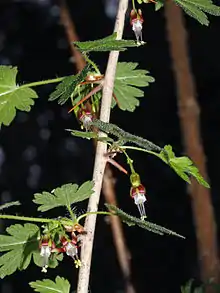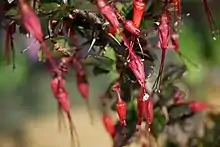Ribes
Ribes /ˈraɪbiːz/[5] is a genus of about 200 known species of flowering plants native throughout the temperate regions of the Northern Hemisphere.[2] The various species are known as currants or gooseberries, and some are cultivated for their edible fruit or as ornamental plants. Ribes is the only genus in the family Grossulariaceae.
| Ribes | |
|---|---|
 | |
| Ribes divaricatum (spreading gooseberry) | |
| Scientific classification | |
| Kingdom: | Plantae |
| Clade: | Tracheophytes |
| Clade: | Angiosperms |
| Clade: | Eudicots |
| Order: | Saxifragales |
| Family: | Grossulariaceae DC.[1] |
| Genus: | Ribes L. |
| Type species | |
| Ribes rubrum L. | |
| Diversity[2] | |
| About 200 species | |
 | |
| Distribution of Ribes species | |
| Synonyms[3][4] | |
| |
Description
Shrub like plants with marked diversity in strikingly diverse flowers and fruit.[6]
Taxonomy
Ribes is the single genus in the Saxifragales family Grossulariaceae. Although once included in the broader circumscription of Saxifragaceae sensu lato, it is now positioned as a sister group to Saxifragaceae sensu stricto.[7]
Subdivision
First treated on a worldwide basis in 1907,[8] the infrageneric classification has undergone many revisions,[9] and even in the era of molecular phylogenetics there has been contradictory evidence.[6] Although sometimes treated as two separate genera, Ribes and Grossularia (Berger 1924),[10] the consensus has been to consider it as a single genus, divided into a number of subgenera, the main ones of which are subgenus Ribes (currants) and subgenus Grossularia (gooseberries), further subdivided into sections.[9] Janczewski (1907) considered six subgenera and eleven sections.[8] Berger's twelve subgenera based on two distinct genera (see Senters & Soltis (2003) Table 1) have subsequently been demoted to sections.[7][6] Weigend (2007) elevated a number of sections to produce a taxonomy of seven subgenera; Ribes (sections Ribes, Heretiera, Berisia) Coreosma, Calobotrya (sections Calobotrya, Cerophyllum), Symphocalyx, Grossularioides, Grossularia, Parilla.[11][12]
Taxonomy, according to Berger, modified by Sinnott (1985):[7][6]
- Subgenus Ribes L. (currants) 8 sections
- Section Berisia Spach (alpine currants)
- Section Calobotrya (Spach) Jancz. (ornamental currants)
- Section Coreosma (Spach) Jancz. (black currants)
- Section Grossularioides ( Jancz.) Rehd. (spiny or Gooseberry-stemmed currants)
- Section Heritiera Jancz. (dwarf or skunk currants)
- Section Parilla Jancz. (Andine or South American currants)
- Section Ribes L. (red currants)
- Section Symphocalyx Berland. (golden currants)
- Subgenus Grossularia (Mill.) Pers. (Gooseberies) 4 sections
Some authors continued to treat Hesperia and Lobbia as subgenera.[13][6] Early molecular studies suggested that subgenus Grossularia was actually embedded within subgenusRibes.[14] Analysis of combined molecular datasets confirms subgenus Grossularia as a monophyletic group, with two main lineages, sect. Grossularia and another clade consisting of glabrous gooseberies, including Hesperia, Lobbia and Robsonia. Other monophyletic groups identified were Calobotrya, Parilla, Symphocalyx and Berisia. However sections Ribes, Coreosma and Heritiera were not well supported. Consequently, there is insufficient resolution to justify further taxonomic revision.[6]
Species
There are around 200 species of Ribes.[2] Selected species include:
Distribution and habitat
Ribes is widely distributed through the Northern Hemisphere, and also extending south in the mountainous areas of South America.[6]
Cultivation

The genus Ribes includes the edible currants: blackcurrant, redcurrant and white currant, as well as the European gooseberry Ribes uva-crispa and several hybrid varieties. It should not be confused with the dried currants used in cakes and puddings, which are from the Zante currant, a small-fruited cultivar of the grape Vitis vinifera. Ribes gives its name to the popular blackcurrant cordial Ribena.
The genus also includes the group of ornamental plants collectively known as the flowering currants, for instance R. sanguineum.
There are restrictions on growing some Ribes species in some U.S. states, as they are the main alternate host for white pine blister rust.
Historical use
Blackfoot Indians used blackcurrant root (Ribes hudsonianum) for the treatment of kidney diseases and menstrual and menopausal problems. Cree Indians used the fruit of Ribes glandulosum as a fertility enhancer to assist women in becoming pregnant.[15]
Ecology
Currants are used as food plants by the larvae of some Lepidoptera species (see List of Lepidoptera that feed on currants).
References
- APG IV 2016.
- "Ribes L." Plants of the World Online. Royal Botanic Gardens, Kew. Retrieved 12 August 2020.
- Morin 2008.
- Lu, Lingdi; Alexander, Crinan. "Ribes". Flora of China. 8 – via eFloras.org, Missouri Botanical Garden, St. Louis, MO & Harvard University Herbaria, Cambridge, MA.
- "ribes". Oxford English Dictionary (Online ed.). Oxford University Press. (Subscription or participating institution membership required.)
- Schultheis & Donoghue 2004.
- Messinger 1995.
- Janczewski 1907.
- Sinnott 1985.
- Berger 1924.
- Weigend et al 2002.
- Weigend 2007.
- Messinger et al 1999.
- Senters & Soltis 2003.
- Tilford, Gregory L. (1997). Edible and Medicinal Plants of the West. Missoula: Mountain Press Publishing. ISBN 978-0-87842-359-0.
Bibliography
Books and theses
- Brennan, Rex M. (1996). "Currants and Gooseberries". In Janick, Jules; Moore, James N. (eds.). Fruit Breeding. II: Vine and small fruits. Wiley. pp. 191–298. ISBN 978-0-471-12670-6.
- Brennan, Rex M. (2008). "Currants and gooseberries" (PDF). In Janick, Jules; Paull, Robert E. (eds.). The Encyclopedia of Fruit and Nuts. CABI. ISBN 978-0-85199-638-7.
- Brennan, R. M. (2008). "Currants and Gooseberries". In Hancock, Jim F. (ed.). Temperate Fruit Crop Breeding: Germplasm to Genomics. Springer Science & Business Media. pp. 177–196. doi:10.1007/978-1-4020-6907-9_6. ISBN 978-1-4020-6907-9.
- Brennan, R M; et al. (2014). "Berries: Currants and gooseberries". In Dixon, Geoffrey R.; Aldous, David E. (eds.). Horticulture: Plants for People and Places, Volume 1: Production Horticulture. Springer. pp. 313–317. ISBN 978-94-017-8578-5.
- Byng, James W. (2014). "Saxifragales". The Flowering Plants Handbook: A practical guide to families and genera of the world. Plant Gateway Ltd. pp. 156–166. ISBN 978-0-9929993-1-5.
- Christenhusz, Maarten J. M.; Fay, Michael F.; Chase, Mark W. (2017). "Saxifragales". Plants of the World: An Illustrated Encyclopedia of Vascular Plants. University of Chicago Press. pp. 231–244. ISBN 978-0-226-52292-0.
- Kubitzki, Klaus, ed. (2007). Flowering Plants. Eudicots: Berberidopsidales, Buxales, Crossosomatales, Fabales p.p., Geraniales, Gunnerales, Myrtales p.p., Proteales, Saxifragales, Vitales, Zygophyllales, Clusiaceae Alliance, Passifloraceae Alliance, Dilleniaceae, Huaceae, Picramniaceae, Sabiaceae. The Families and Genera of Vascular Plants. IX. Springer. ISBN 978-3-540-32219-1.
- Weigend, M (2007). Grossulariaaceae. pp. 168–176., in Kubitzki (2007)
- Messinger, Wes (1995). Molecular Systematic Studies in the Genus Ribes (Grossulariaceae) (Thesis). Department of Botany and Plant Pathology, Oregon State University.
Articles
- Angiosperm Phylogeny Group IV (2016). "An update of the Angiosperm Phylogeny Group classification for the orders and families of flowering plants: APG IV". Botanical Journal of the Linnean Society. 181 (1): 1–20. doi:10.1111/boj.12385.
- Berger, A (1924). "A taxonomic review of currants and gooseberries". Bulletin of the New York State Agricultural Experimental Station (109): 1–118.
- Christenhusz, Maarten JM & Byng, J. W. (2016). "The number of known plants species in the world and its annual increase". Phytotaxa. Magnolia Press. 261 (3): 201–217. doi:10.11646/phytotaxa.261.3.1.
- Hummer, Kim E.; Barney, Danny L. (July–September 2002). "Crop Reports: Currants" (PDF). HortTechnology. 12 (3): 377–387. doi:10.21273/HORTTECH.12.3.377.
- Janczewski, Edward (1907). "Monographies des groseilliers, Ribes L.". Mémoires de la Société de Physique et d'Histoire Naturelle de Genève. 35: 199–517.
- Messinger, Wes; Hummer, Kim; Liston, Aaron (1999). "Ribes (Grossulariaceae) phylogeny as indicated by restriction-site polymorphisms of PCR-amplified chloroplast DNA". Plant Systematics and Evolution. 217 (3–4): 185–195. doi:10.1007/BF00984364. JSTOR 23643670. S2CID 20696263.
- Schultheis, Lisa M.; Donoghue, Michael J. (1 January 2004). "Molecular Phylogeny and Biogeography of Ribes (Grossulariaceae), with an Emphasis on Gooseberries (subg. Grossularia)" (PDF). Systematic Botany. 29 (1): 77–96. doi:10.1600/036364404772974239. S2CID 85938994.
- Senters, Anne E.; Soltis, Douglas E. (2003). "Phylogenetic Relationships in Ribes (Grossulariaceae) Inferred from ITS Sequence Data". Taxon. 52 (1): 51–66. doi:10.2307/3647301. ISSN 0040-0262. JSTOR 3647301.
- Sinnott, Quinn P. (1985). "A revision of Ribes L. subg. Grossularia (Mill.) Pers. sect. Grossularia (Mill.) Nutt. (Grossulariaceae) in North America". Rhodora. 87 (850): 189–286. ISSN 0035-4902. JSTOR 23314591.
- Weigend, Maximilian; Mohr, Oliver; Motley, Timothy J. (1 August 2002). "Phylogeny and classification of the genus Ribes (Grossulariaceae) based on 5S-NTS sequences and morphological and anatomical data". Botanische Jahrbücher. 124 (2): 163–182. doi:10.1127/0006-8152/2002/0124-0163.
Websites
- Morin, Nancy R (2008). "Ribes Linnaeus". Flora of North America vol. 8. New York: Oxford University Press. pp. 8, 9, 10, 44. Retrieved 12 November 2019.
- . Encyclopædia Britannica (11th ed.). 1911.
- "Introduction to blackcurrant". FruitGateway. Aberdeen: The James Hutton Institute.
- Entry on Ribes at Mark Rieger's UGa fruit crops site
External links
![]() Media related to Ribes at Wikimedia Commons
Media related to Ribes at Wikimedia Commons